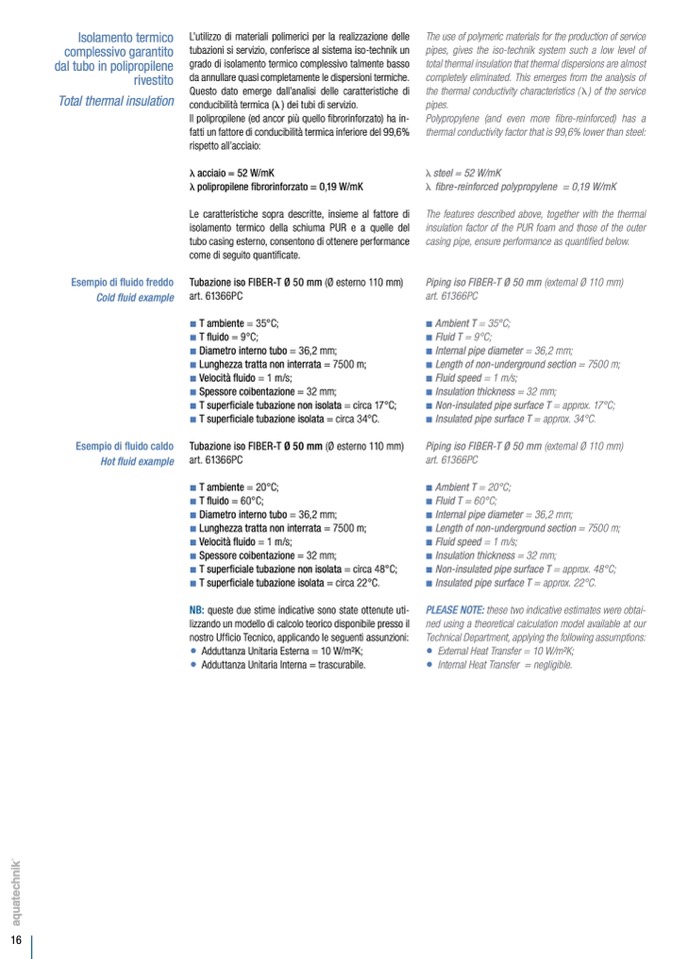
Isolamento termico
complessivo garantito
dal tubo in polipropilene
rivestito
Total thermal insulation
L’utilizzo di materiali polimerici per la realizzazione delle
tubazioni si servizio, conferisce al sistema iso-technik un
grado di isolamento termico complessivo talmente basso
da annullare quasi completamente le dispersioni termiche.
Questo dato emerge dall’analisi delle caratteristiche di
conducibilità termica (l ) dei tubi di servizio.
Il polipropilene (ed ancor più quello fibrorinforzato) ha in-
fatti un fattore di conducibilità termica inferiore del 99,6%
rispetto all’acciaio:
l acciaio = 52 W/mK
l polipropilene fibrorinforzato = 0,19 W/mK
Le caratteristiche sopra descritte, insieme al fattore di
isolamento termico della schiuma PUR e a quelle del
tubo casing esterno, consentono di ottenere performance
come di seguito quantificate.
Tubazione iso FIBER-T Ø 50 mm (Ø esterno 110 mm)
art. 61366PC
n T ambiente = 35°C;
nTfluido=9°C;
n Diametro interno tubo = 36,2 mm;
nLunghezza tratta non interrata = 7500 m;
n Velocità fluido = 1 m/s;
n Spessore coibentazione = 32 mm;
nT superficiale tubazione non isolata = circa 17°C;
nT superficiale tubazione isolata = circa 34°C.
Tubazione iso FIBER-T Ø 50 mm (Ø esterno 110 mm)
art. 61366PC
n T ambiente = 20°C;
n T fluido = 60°C;
n Diametro interno tubo = 36,2 mm;
nLunghezza tratta non interrata = 7500 m;
n Velocità fluido = 1 m/s;
n Spessore coibentazione = 32 mm;
nT superficiale tubazione non isolata = circa 48°C;
nT superficiale tubazione isolata = circa 22°C.
NB: queste due stime indicative sono state ottenute uti-
lizzando un modello di calcolo teorico disponibile presso il
nostro Ufficio Tecnico, applicando le seguenti assunzioni:
•
Adduttanza Unitaria Esterna = 10 W/m2K;
•
Adduttanza Unitaria Interna = trascurabile.
The use of polymeric materials for the production of service
pipes, gives the iso-technik system such a low level of
total thermal insulation that thermal dispersions are almost
completely eliminated. This emerges from the analysis of
the thermal conductivity characteristics ( l ) of the service
pipes.
Polypropylene (and even more fibre-reinforced) has a
thermal conductivity factor that is 99,6% lower than steel:
l steel = 52 W/mK
l fibre-reinforced polypropylene = 0,19 W/mK
The features described above, together with the thermal
insulation factor of the PUR foam and those of the outer
casing pipe, ensure performance as quantified below.
Piping iso FIBER-T Ø 50 mm (external Ø 110 mm)
art. 61366PC
n Ambient T = 35°C;
nFluid T = 9°C;
n Internal pipe diameter = 36,2 mm;
nLength of non-underground section = 7500 m;
n Fluid speed = 1 m/s;
n Insulation thickness = 32 mm;
n Non-insulated pipe surface T = approx. 17°C;
n Insulated pipe surface T = approx. 34°C.
Piping iso FIBER-T Ø 50 mm (external Ø 110 mm)
art. 61366PC
n Ambient T = 20°C;
n Fluid T = 60°C;
n Internal pipe diameter = 36,2 mm;
nLength of non-underground section = 7500 m;
n Fluid speed = 1 m/s;
n Insulation thickness = 32 mm;
n Non-insulated pipe surface T = approx. 48°C;
n Insulated pipe surface T = approx. 22°C.
PLEASE NOTE: these two indicative estimates were obtai-
ned using a theoretical calculation model available at our
Technical Department, applying the following assumptions:
•
External Heat Transfer = 10 W/m2K;
•
Internal Heat Transfer = negligible.
Esempio di fluido freddo
Cold fluid example
Esempio di fluido caldo
Hot fluid example
16

